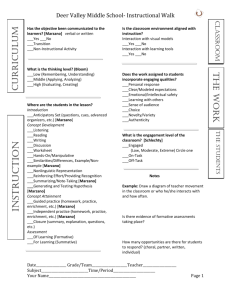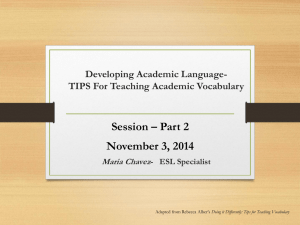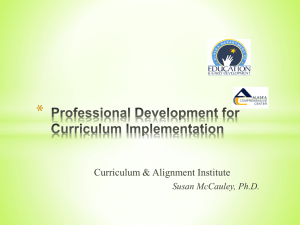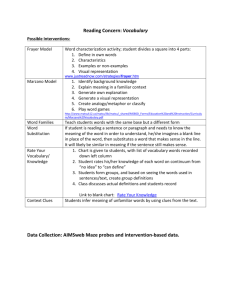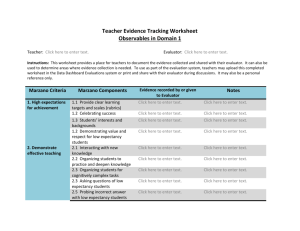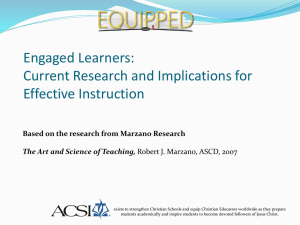Using Rounds to Enhance Teacher Interaction and Self
advertisement
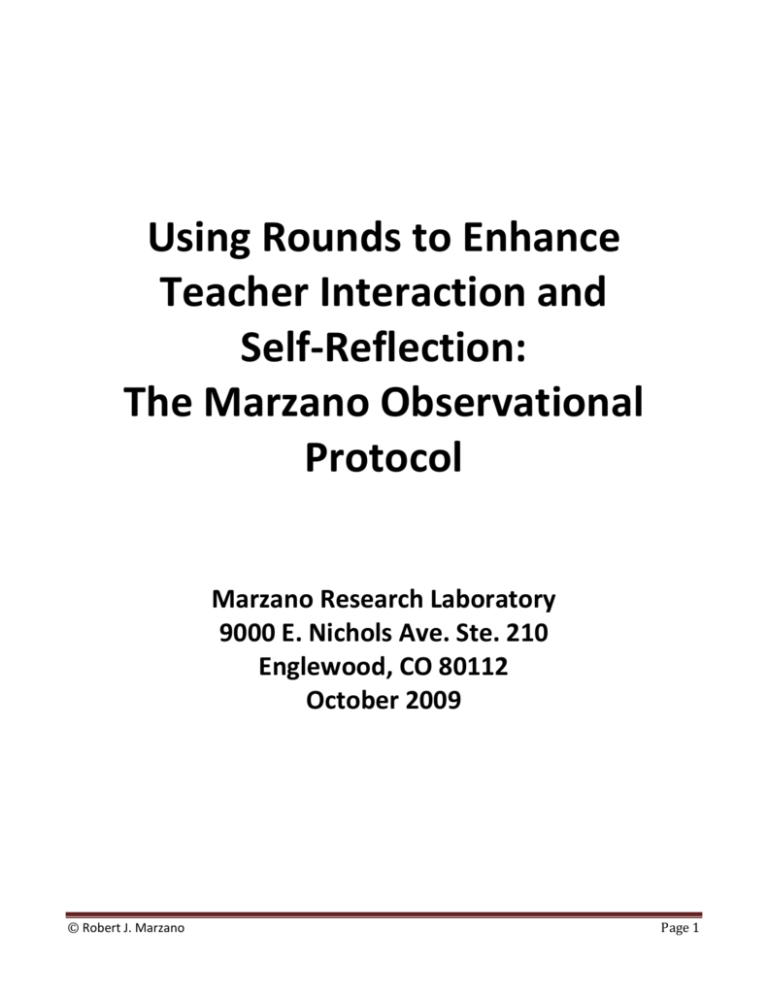
Using Rounds to Enhance Teacher Interaction and Self‐Reflection: The Marzano Observational Protocol Marzano Research Laboratory 9000 E. Nichols Ave. Ste. 210 Englewood, CO 80112 October 2009 © Robert J. Marzano Page 1 Instructional Rounds During instructional rounds, small groups of teachers make relatively brief observations of their fellow teachers. These observations are longer than a typical “walkthrough” (i.e., longer than a few minutes), but usually shorter than an entire class period. When engaged in rounds, groups of teachers conduct as many substantive observations of classrooms as possible within part of a day or the entire day. For example, a group of teachers might spend an entire morning conducting rounds and then discuss their experiences in the afternoon. Another option is to discuss experiences immediately after each observation. Instructional rounds are usually not used to provide feedback to the teacher being observed, although this is an option if the observed teacher so desires. Consequently, the observing group of teachers may summarize their observations and make these comments available to the observed teacher. This notwithstanding, the primary purpose of instructional rounds is for the teachers making the observations to compare their practices with those observed in the classrooms they visit. It is the discussion at the end of a set of instructional rounds and the subsequent self‐reflection by observer teachers that is their chief benefit. Setting Up Instructional Rounds Ideally, every teacher should have a chance to participate in instructional rounds at least once per semester. If this is not possible, then once a year will have to suffice. Rounds should be facilitated by a lead teacher—someone who is respected by colleagues as an exceptional teacher and recognized as a professional. Instructional coaches commonly fit these characteristics. Administrators may also lead rounds, but it should be made clear from the outset that their purpose is not to evaluate the teachers being observed. Teachers who are observed are typically volunteers. Ideally, these volunteers are drawn from the pool of master teachers in a building—those veterans who have proven their ability to enhance the achievement of all students in their classes. This noted, any teacher might offer his or her classroom as a venue for rounds. © Robert J. Marzano Page 2 Groups conducting rounds are usually small in numbers—three to five, not counting the lead teachers. On the day rounds are scheduled, teachers being observed alert their classes that they will have some other teachers visiting their classroom. Observed teachers might explain to their students that teachers in the building are trying to learn from one another just as students learn from one another. Before the observer teachers enter a classroom, they knock at the door and then quietly move to an area of the classroom that does not disrupt the flow of instruction. This is usually somewhere at the back of the classroom. There, they observe what is occurring and makes notes on their observational forms. At the end of the observation, the observer team exits the classroom making sure to thank the observed teacher and the students. What to Observe Observations are based on The Art and Science of Teaching (Marzano, 2007), which is a comprehensive framework for effective instruction. The basis of The Art and Science of Teaching is 10 design questions used by teachers to plan effective units and lessons within those units. These design questions are depicted in Figure 1. Figure 1: Design Questions from The Art and Science of Teaching 1. What will I do to establish and communicate learning goals, track student progress, and celebrate success? 2. What will I do to help students effectively interact with new knowledge? 3. What will I do to help students practice and deepen their understanding of new knowledge? 4. What will I do to help students generate and test hypotheses about new knowledge? 5. What will I do to engage students? 6. What will I do to establish or maintain classroom rules and procedures? 7. What will I do to recognize and acknowledge adherence and lack of adherence to classroom rules and procedures? © Robert J. Marzano Page 3 8. What will I do to establish and maintain effective relationships with students? 9. What will I do to communicate high expectations for all students? 10. What will I do to develop effective lessons organized into a cohesive unit? These design questions not only provide a planning framework for teachers, but they also provide a framework for observing classroom instruction. For this later purpose, the design questions must be reorganized to represent three different categories of behavior or “lesson segments” that occur in classrooms. These three types of segments are: Lesson Segments That Involve Routine Events That Might be Observed in Every Lesson: Design Question 1: What will I do to establish and communicate learning goals, track student progress, and celebrate success? Design Question 6: What will I do to establish or maintain classroom rules and procedures? Lesson Segments That Address Content: Design Question 2: What will I do to help students effectively interact with new knowledge? Design Question 3: What will I do to help students practice and deepen their understanding of new knowledge? Design Question 4: What will I do to help students generate and test hypotheses about new knowledge? Lesson Segments That Are Enacted on the Spot: Design Question 5: What will I do to engage students? Design Question 7: What will I do to recognize and acknowledge adherence and lack of adherence to classroom rules and procedures? Design Question 8: What will I do to establish and maintain effective relationships with students? Design Question 9: What will I do to communicate high expectations for all students? Design Question 10 is not included in the Observational Protocol because it involves the organization of lessons into cohesive units and, therefore, is not amenable to observation during a specific lesson. © Robert J. Marzano Page 4 To facilitate observation of these elements, the design questions should be translated into questions that are asked about the teacher being observed. This is depicted in Figure 2. Figure 2: Marzano Observational Protocol Snapshot Form Lesson Segments That Involve Routine Events That Might be Observed in Every Lesson: What is the teacher doing to help establish and communicate learning goals, track student progress, and celebrate success? What is the teacher doing to establish or maintain classroom rules and procedures? Lesson Segments That Address Content: What is the teacher doing to help students effectively interact with new knowledge? What is the teacher doing to help students practice and deepen their understanding of new knowledge? What is the teacher doing to help students generate and test hypotheses about new knowledge? © Robert J. Marzano Page 5 Lesson Segments That Are Enacted on the Spot: What is the teacher doing to engage students? What is the teacher doing to recognize and acknowledge adherence and lack of adherence to classroom rules and procedures? What is the teacher doing to establish and maintain effective relationships with students? What is the teacher doing to communicate high expectations for all students? © Robert J. Marzano Page 6 Notice that the Snapshot Form in Figure 2 boils down to asking nine questions about the observed teacher: Lesson Segments That Involve Routine Events That Might be Observed in Every Lesson: What is the teacher doing to help establish and communicate learning goals, track student progress, and celebrate success? What is the teacher doing to establish or maintain classroom rules and procedures? Lesson Segments That Address Content: What is the teacher doing to help students effectively interact with new knowledge? What is the teacher doing to help students practice and deepen their understanding of new knowledge? What is the teacher doing to help students generate and test hypotheses about new knowledge? Lesson Segments That Are Enacted on the Spot: What is the teacher doing to engage students? What is the teacher doing to recognize and acknowledge adherence and lack of adherence to classroom rules and procedures? What is the teacher doing to establish and maintain effective relationships with students? What is the teacher doing to communicate high expectations for all students? Keeping this in mind makes classroom observations a relatively straightforward process. © Robert J. Marzano Page 7 How to Observe When using the Snapshot Form of the Observational Protocol (or any other form), the observer must continually ask himself or herself the following questions: What am I observing right now? Is it a lesson segment that involves routine behaviors that might be observed in every lesson? Is it a lesson segment that addresses content in specific ways? Is it a lesson segment that must be enacted on the spot? In the case of content lesson segments, the observer must further ask himself or herself the following questions: Is this a lesson segment involving new content? Is this a lesson segment involving practicing and deepening knowledge? Is this a lesson segment involving hypothesis generation and testing? Focusing on what is occurring during a specific interval of time, the observer makes notes in the appropriate section of the Snapshot Form of the Observational Protocol. A more detailed form of the Marzano Observational Protocol can be found at the end of this document (see Marzano Observational Protocol Short Form). There, specific elements are listed for each of the nine questions addressed during an observation. For electronic versions of these forms that are even more detailed, visit www.iObservation.com/MarzanoSuite. It is important to note that none of the forms in this document may be digitized without expressed written consent. Along with trying to observe what is occurring during specific classroom segments, observers should record their perceptions in the protocol immediately after leaving the observed teacher’s classroom. This allows observers to pick up behaviors they did not have time to record while in the classroom. To do this “after action” recording, observers simply read through the questions and record anything that comes to mind regarding what occurred in the classroom. © Robert J. Marzano Page 8 How to Debrief After rounds have been conducted, members of the observing team convene to debrief on their experiences. They do so by discussing each observation one at a time. This can be done in a round‐ robin format where each observer teacher comments on what he or she noted. The leader of the rounds facilitates this process. The leader starts by reminding everyone that the purpose of the discussion is not to evaluate the observed teacher. Rules regarding how to share observations should be established prior to the debriefing. Useful rules include: Comments made during the debriefing should not be shared with anyone. Do not offer suggestions to the observed teachers unless they explicitly ask for feedback. Nothing observed within a lesson should be shared with anyone. Observed teachers should be thanked and acknowledged for their willingness to open their classrooms to others. As observer teachers take turns commenting on what they saw in a particular classroom, it is useful to use a “pluses” and “deltas” format. The observer teacher begins by noting the positive things he or she observed in the classroom. Next, the observer may mention some questions (deltas) he or she had about the teacher’s use of strategies. Finally, the observer teacher compares and contrasts his or her classroom strategies with one or more of the techniques observed. This process is completed for each classroom observed. For any particular observation, an observer teacher can opt not to share his or her analysis with the group. The debriefing should end with all observer teachers identifying one thing they might do differently in their classroom as a result of the rounds. © Robert J. Marzano Page 9 References Marzano, R. J. (2007). The Art and Science of Teaching: A Comprehensive Framework for Effective Instruction. Alexandria, VA: Association for Supervision and Curriculum Development. © Robert J. Marzano Page 10 Marzano Observational Protocol Snapshot Form (This form may not be digitized.) © Robert J. Marzano Page 11 Marzano Observational Protocol Snapshot Form Lesson Segments That Involve Routine Events That Might be Observed in Every Lesson: What is the teacher doing to help establish and communicate learning goals, track student progress, and celebrate success? What is the teacher doing to establish or maintain classroom rules and procedures? Lesson Segments That Address Content: What is the teacher doing to help students effectively interact with new knowledge? What is the teacher doing to help students practice and deepen their understanding of new knowledge? What is the teacher doing to help students generate and test hypotheses about new knowledge? Lesson Segments That Are Enacted on the Spot: What is the teacher doing to engage students? © Robert J. Marzano Page 12 What is the teacher doing to recognize and acknowledge adherence and lack of adherence to classroom rules and procedures? What is the teacher doing to establish and maintain effective relationships with students? What is the teacher doing to communicate high expectations for all students? © Robert J. Marzano Page 13 Marzano Observational Protocol Short Form (This form may not be digitized.) © Robert J. Marzano Page 14 Marzano Observational Protocol Short Form I I. Lesson Segments Involving Routine Events Design Question #1: What is the teacher doing to establish and communicate learning goals, track student progress, and celebrate success? 3. Celebrating student success (e.g., the teacher helps students acknowledge and celebrate current status on a learning goal as well as knowledge gain) Notes Design Question #6: What is the teacher doing to establish and maintain classroom rules and procedures? 5. Organizing the physical layout of the classroom for learning (e.g., the teacher organizes materials, traffic patterns, and displays to enhance learning) Notes 4. Establishing classroom routines (e.g., the teacher reminds students of a rule or procedure or establishes a new rule or procedure) Notes Notes 2. Tracking student progress (e.g., using formative assessment, the teacher helps students chart their individual and group progress on a learning goal) Notes 1. Providing clear learning goals and scales to measure those goals (e.g., the teacher provides or reminds students about a specific learning goal) II. Lesson Segments Addressing Content Design Question #2: What is the teacher doing to help students effectively interact with new knowledge? 7. Organizing students to interact with new knowledge (e.g., the teacher organizes students into dyads or triads to discuss small chunks of content) 8. Previewing new content (e.g., the teacher uses strategies such as K‐W‐L, advance organizers, preview questions) © Robert J. Marzano Notes Notes 6. Identifying critical information (e.g., the teacher provides cues as to which information is important) Notes Page 15 12. Recording and representing knowledge (e.g., the teacher asks students to summarize, take notes, or use non‐ linguistic representations) 13. Reflecting on learning (e.g., the teacher asks students to reflect on what they understand or what they are still confused about) Notes Notes Notes 11. Elaborating on new information (e.g., the teacher asks questions that require students to make and defend inferences) Notes 10. Group processing of new information (e.g., after each chunk of information, the teacher asks students to summarize and clarify what they have experienced) Notes 9. Chunking content into “digestible bites” (e.g., the teacher presents content in small portions that are tailored to students’ level of understanding) 18. Examining errors in reasoning (e.g., the teacher asks students to examine informal fallacies, propaganda, and bias) 19. Practicing skills, strategies, and processes (e.g., the teacher uses massed and distributed practice) 20. Revising knowledge (e.g., the teacher asks students to revise entries in notebooks to clarify and add to previous information) © Robert J. Marzano Notes Notes Notes 17. Examining similarities and differences (e.g., the teacher engages students in comparing, classifying, and creating analogies and metaphors) Notes 16. Using homework (e.g., the teacher uses homework for independent practice or to elaborate on information) Notes 15. Organizing students to practice and deepen knowledge (e.g., the teacher organizes students into groups designed to review information or practice skills) Notes 14. Reviewing content (e.g., the teacher briefly reviews related content addressed previously) Notes Design Question #3: What is the teacher doing to help students practice and deepen their understanding of new knowledge? Page 16 22. Engaging students in cognitively complex tasks involving hypothesis generating and testing (e.g., the teacher engages students in decision‐making tasks, problem‐solving tasks, experimental‐inquiry tasks, and investigation tasks) 23. Providing resources and guidance (e.g., the teacher makes resources available that are specific to cognitively complex tasks and helps students execute such tasks) Notes 21. Organizing students for cognitively complex tasks (e.g., the teacher organizes students into small groups to facilitate cognitively complex tasks) Notes Design Question #4: What is the teacher doing to help students generate and test hypotheses about new knowledge? Notes III. Lesson Segments Enacted on the Spot 27. Using physical movement (e.g., the teacher uses strategies that require students to move physically such as vote with your feet and physical reenactments of content) 28. Maintaining a lively pace (e.g., the teacher slows and quickens the pace of instruction to enhance engagement) 29. Demonstrating intensity and enthusiasm (e.g., the teacher uses verbal and nonverbal signals that show he or she is enthusiastic about the content) © Robert J. Marzano Notes Notes Notes 26. Managing response rates during questioning (e.g., the teacher uses strategies to ensure that multiple students respond to questions such as response cards, response chaining, and voting technologies) Notes 25. Using academic games (e.g., when students are not engaged, the teacher uses adaptations of popular games to reengage them and focus their attention on academic content) Notes 24. Noticing and reacting when students are not engaged (e.g., the teacher scans the classroom to monitor students’ level of engagement) Notes Design Question #5: What is the teacher doing to engage students? Page 17 32. Presenting unusual or intriguing information (e.g., the teacher provides or encourages the identification of intriguing information about the content) Notes 34. Applying consequences (e.g., the teacher applies consequences to lack of adherence to rules and procedures consistently and fairly) 35. Acknowledging adherence to rules and procedures (e.g., the teacher acknowledges adherence to rules and procedures consistently and fairly) Notes 33. Demonstrating “withitness” (e.g., the teacher is aware of variations in student behavior that might indicate potential disruptions and attends to them immediately) Notes Design Question #7: What is the teacher doing to recognize and acknowledge adherence or lack of adherence to rules and procedures? Notes Notes 31. Providing opportunities for students to talk about themselves (e.g., the teacher uses techniques that allow students to relate content to their personal lives and interests) Notes 30. Using friendly controversy (e.g., the teacher uses techniques that require students to take and defend a position about content) Design Question #8: What is the teacher doing to establish and maintain effective relationships with students? 38. Displaying objectivity and control (e.g., the teacher behaves in ways that indicate he or she does not take infractions personally) Notes Design Question #9: What is the teacher doing to communicate high expectations for all students? © Robert J. Marzano Notes 37. Using behaviors that indicate affection for students (e.g., the teacher uses humor and friendly banter appropriately with students) Notes 36. Understanding students’ interests and backgrounds (e.g., the teacher seeks out knowledge about students and uses that knowledge to engage in informal, friendly discussions with students) Page 18 41. Probing incorrect answers with low‐expectancy students (e.g., the teacher inquires into incorrect answers with low‐ expectancy students with the same depth and rigor as with high‐expectancy students) Notes Notes 40. Asking questions of low‐expectancy students (e.g., the teacher asks questions of low‐expectancy students with the same frequency and level of difficulty as with high‐ expectancy students) Notes 39. Demonstrating value and respect for low‐expectancy students (e.g., the teacher demonstrates the same positive, affective tone with low‐expectancy students as with high‐ expectancy students) © Robert J. Marzano Page 19
